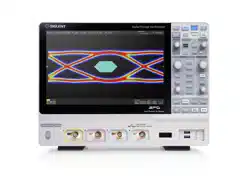Loading ...
Loading ...
Loading ...

SDS6000A Series Digital Oscilloscope User Manual
int.siglent.com 325
+Width@C2C
Difference between the positive pulse width of two continuous
cycles, only for clock data.
-Width@C2C
Difference between the negative pulse width of two continuous
cycles, only for clock data.
+Duty@C2C
Difference between the positive duty cycle of two adjacent
cycles, only for clock data.
-Duty@C2C
Difference between the negative duty cycle of two adjacent
cycles, only for clock data.
Decomposition
TIE
Time Interval Error (TIE), the time difference between the signal
edge and the reference clock.
RJ
Random jitter (RJ) also called Gaussian jitter, is unpredictable
electronic timing noise. RJ is caused by thermal noise in an
electrical circuit or due to the central limit theorem. Random jitter
is unbounded and commonly specified by the standard deviation
σ. Due to its irregular nature, random jitter (RJ) is uncorrelated
to any other signal and unpredictable in timing behavior.
DJ
Deterministic jitter, the observed peak-to-peak value will not
grow over time, has a bounded distribution.
DCD
Duty cycle distortion (DCD) is the difference between mean TIE
for rising edges and mean TIE for falling edges. Asymmetrical
rise-time vs. fall-time and non-optimal choice of decision
threshold will cause DCD.
DDJ
Data-dependent jitter (DDJ) has several discrete line
distributions, main caused by ISI, the physical/electrical effect.
There will be different zero-crossing positions, due to
transmission line effects like reflections and the step response
of the system.
PJ
Periodic jitter (PJ) is mainly caused by the periodic signal
interference on the board, including power supply ripple, clock
crosstalk, etc. Periodic interference can directly cause phase
modulation of the observed signal.
TJ@BER
Total jitter (TJ) is computed with a required bit error rate (BER)
for the system:
The value of
changes according to different bit error
rates. A common BER used in communication standards such
as Ethernet is 10
−12
,
Loading ...
Loading ...
Loading ...
